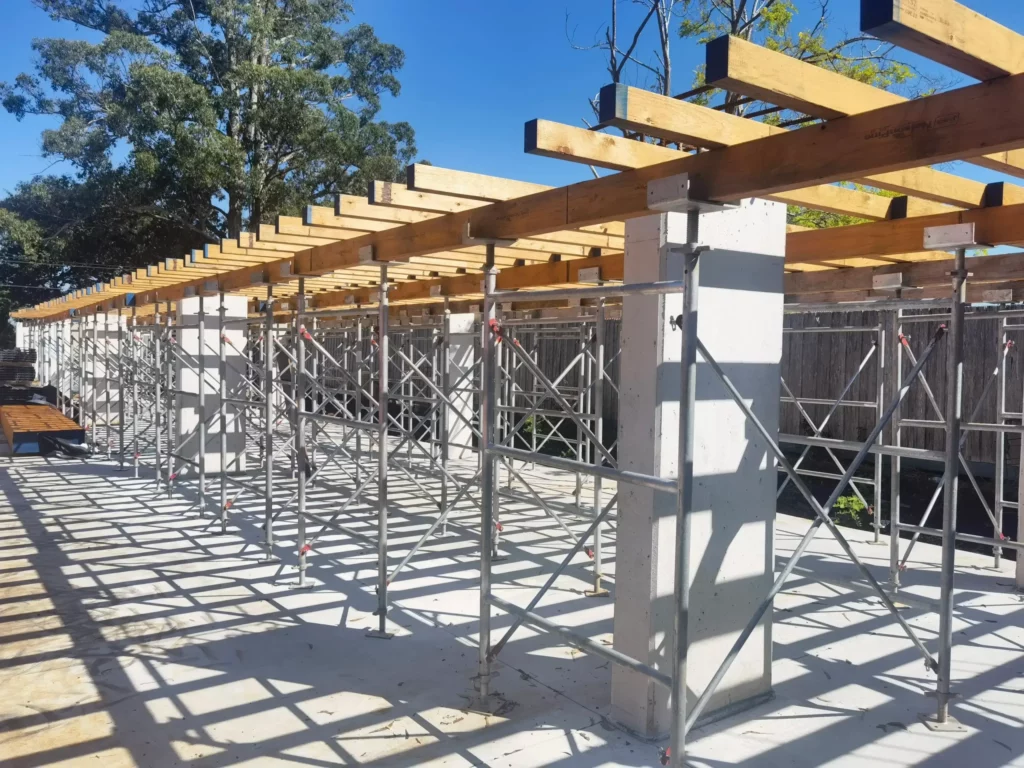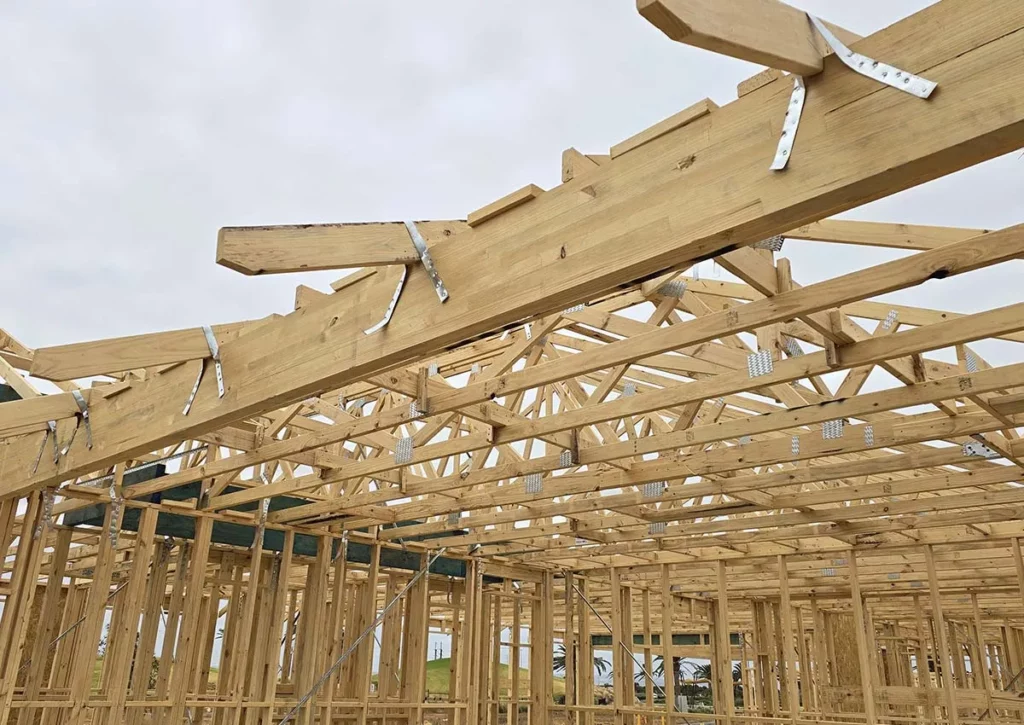What Are LVL Construction Beams and How Are They Traditionally Used in Concrete Formwork?
LVL (Laminated Veneer Lumber) construction beams are an advanced engineered wood product made using a complex manufacturing process. These high-performance beams are made up of several layers of thin wood veneers that are glued together under high heat and pressure. The grain of each veneer layer runs parallel to the length of the beam, resulting in a very strong and stable structural component.
Composition of LVL Beams
The typical composition of LVL beams includes:
- Wood Species: Premium hardwoods or softwoods
- Veneer Thickness: 2.5mm to 4.8mm layers
- Adhesive: High-grade structural adhesives
- Treatment: Protective treatments against moisture and pests
Green building certifications like LEED and BREEAM are driving increased adoption of LVL construction beams. These certification systems reward the use of sustainable materials, pushing developers to choose engineered wood products over traditional construction materials.
Traditional Uses of LVL Beams in Concrete Formwork
In concrete formwork applications, LVL beams play a crucial role as support elements. They are used for:
- Supporting horizontal formwork panels
- Creating sturdy vertical shores
- Establishing precise concrete pour heights
- Maintaining formwork alignment during concrete placement

The strength of LVL beams makes them well-suited for formwork applications, offering:
- Minimal Deflection: Maintains concrete shape accuracy
- High Load Capacity: Supports wet concrete weight safely
- Dimensional Stability: Ensures consistent form geometry
- Reusability: Multiple project applications when properly maintained
These qualities have made LVL beams a reliable choice in concrete formwork systems on construction sites across Australia, especially in commercial and infrastructure projects where precision and dependability are critical.
Find more on: How to Safely Handle and Install Reobars on Site
What Structural Advantages Do LVL Beams Offer Compared to Conventional Timber?
LVL beams deliver exceptional structural performance that surpasses traditional timber in multiple ways. The advanced manufacturing process creates beams with 2.5 to 3 times the strength of standard timber of similar dimensions.
Strength and Load-Bearing Capacity
The lamination process aligns wood fibres parallel to the beam length, resulting in:
- Load-bearing capacity up to 3000kg/m²
- Uniform strength distribution throughout the beam
- Minimal natural defects like knots or splits
- Predictable structural behaviour under stress
Shape Retention and Dimensional Stability
Unlike conventional timber, LVL beams maintain their shape and structural integrity through:
- Resistance to twisting and warping
- Enhanced dimensional stability
- Reduced seasonal movement
- Superior moisture resistance
Protection Against Timber Issues
The engineered nature of LVL provides built-in protection against common timber issues:
- Natural resistance to fungal growth
- Increased protection against pest infestations
- Reduced checking and splitting
- Enhanced fire resistance properties
Consistent Quality and Design Confidence
The manufacturing process eliminates natural wood defects, creating a product with consistent quality across every batch. This uniformity allows architects and engineers to design with confidence, knowing the exact performance characteristics of each beam. Find more about quality on https://wfme.org/
Strength-to-Weight Ratio and Design Flexibility
The superior strength-to-weight ratio of LVL means you can achieve longer spans with smaller beam sizes compared to solid timber, creating more design flexibility and efficient material usage in construction projects.

How Are LVL Beams Used as Permanent Structural Elements in Buildings?
LVL beams are strong and durable structural components used in various building applications. They are designed to provide long-lasting support and stability to different areas of a structure. Here are some ways LVL beams are employed as permanent structural elements in buildings:
Residential Construction Applications
In residential construction, LVL beams serve multiple purposes:
- Floor Joists: Supporting floor systems with spans up to 12 metres
- Ridge Beams: Creating sturdy roof structures
- Window Headers: Distributing loads above openings
- Door Frames: Providing stable support for entryways
Commercial Building Benefits
Commercial buildings also benefit from the structural capabilities of LVL beams:
- Large-span roof systems
- Multi-storey floor supports
- Load-bearing wall components
- Column-free open spaces
Architectural Design Features
The aesthetic appeal of LVL beams adds a unique architectural element when left exposed. Architects incorporate these structural members as design features in various spaces:
- Open-plan living areas
- Modern office spaces
- Restaurant ceilings
- Industrial-style lofts
Manufacturing Precision and Customisation
The precise manufacturing process of LVL ensures clean lines and uniform appearances, making it an ideal choice for visible structural elements. Additionally, the material’s natural wood grain patterns bring warmth to interior spaces while maintaining structural integrity.
Custom sizing options further enhance the versatility of LVL beams, allowing builders to meet specific project requirements. With the ability to manufacture LVL beams in lengths up to 20 metres, designers can create expansive, uninterrupted spaces that satisfy both structural demands and aesthetic preferences.
How Do LVL Beams Contribute to Sustainable Construction Practices?
LVL beams are leading the way in sustainable construction practices with their innovative manufacturing process and environmental benefits. These engineered wood products make the most of timber resources by using responsibly sourced logs from certified forests and creating minimal waste during production.
The Environmental Impact of LVL Beams
The environmental impact of LVL beams becomes clear when looking at their carbon footprint:
- Reduced Carbon Emissions: Manufacturing LVL beams requires 60% less energy compared to steel beam production
- Carbon Storage: Each cubic metre of LVL stores approximately 789 kg of carbon dioxide
- Resource Efficiency: LVL production uses 95% of each log, compared to 63% for traditional timber processing, Learn more about carbon dioxide on https://www.ncbi.nlm.nih.gov/books/NBK482456/
Additional Sustainability Benefits
The sustainability advantages go beyond manufacturing:
- Transport Efficiency: LVL’s lighter weight reduces fuel consumption during delivery
- Waste Reduction: Precise engineering means less on-site waste
- Extended Lifespan: LVL beams can last 50+ years with proper maintenance
Alignment with Green Building Certifications
The use of LVL beams fits in with green building certifications, earning points in systems like BREEAM and LEED. Their durability eliminates the need for frequent replacements, reducing the long-term environmental impact of construction projects.
Eco-Friendly Manufacturing Practices
Modern LVL manufacturing processes incorporate recycled wood content and use low-emission adhesives, creating a building material that meets strict environmental standards while maintaining superior structural performance.
How Does the Lamination Process Enhance the Performance of LVL Beams?
The lamination process transforms standard timber into high-performance LVL beams through precise engineering and advanced manufacturing techniques. This sophisticated process involves:
- Peeling logs into thin veneers (2-3mm thick)
- Drying veneers to specific moisture content
- Applying structural adhesives
- Pressing under intense heat and pressure
The strategic layering of wood veneers creates a material that surpasses traditional timber in strength and reliability. Each layer’s grain runs parallel to the beam length, distributing loads evenly across the entire structure.
Modern adhesive technologies play a crucial role in beam performance:
- Phenol-formaldehyde resins create waterproof bonds
- Polyurethane adhesives enhance structural integrity
- Advanced bonding agents resist chemical exposure
These manufacturing advancements result in beams with:
- 2x stronger tensile strength than solid timber
- Enhanced resistance to moisture penetration
- Uniform load-bearing properties
- Reduced susceptibility to natural defects
The controlled manufacturing environment ensures consistent quality across each batch. Temperature and pressure monitoring during lamination creates molecular-level bonds between layers, while automated quality control systems detect and eliminate defects before they reach construction sites.
Recent developments in adhesive technology have pushed LVL performance boundaries, creating beams capable of withstanding harsh environmental conditions while maintaining structural integrity throughout their extended service life. Click here to find more about environmental.
What Key Considerations Should Be Taken Into Account When Selecting LVL Beams for Different Project Needs?
Selecting the right LVL beam requires careful analysis of multiple project-specific factors. Load requirements stand as the primary consideration – you’ll need to calculate both dead and live loads to determine the appropriate beam size.
Essential Load Considerations:
- Span length between supports
- Weight of materials being supported
- Expected foot traffic or equipment loads
- Snow loads in applicable regions
- Wind forces on the structure
The beam’s exposure conditions directly impact its performance and longevity. LVL beams installed in moisture-prone areas need additional protective treatments, while those in temperature-controlled environments might require less stringent specifications.
Environmental Exposure Factors:
- Indoor vs outdoor placement
- Humidity levels
- Direct weather exposure
- Chemical exposure risks
- UV radiation exposure
Custom architectural requirements often demand specialised beam configurations. Australian suppliers offer various sizing options:
- Standard sizes from 130mm to 600mm depths
- Custom lengths up to 13 metres
- Special end cuts and notching services
- Pre-drilled service holes
- Specific surface finishing options
The beam’s intended use influences material grade selection. High-stress applications demand higher-grade LVL beams, while less demanding applications might allow for standard grades, optimising cost-efficiency without compromising safety.
How Do LVL Beams Compare to Other Materials Used Beyond Formwork Applications?
LVL beams offer distinct advantages when compared to traditional construction materials like steel and concrete. Their lightweight nature makes them significantly easier to handle on construction sites, reducing the need for heavy machinery and specialised lifting equipment.
Weight Comparison:
- LVL beams weigh approximately 1/3 of equivalent steel beams
- A typical LVL beam requires 2-3 workers for installation
- Steel beams often need crane assistance and 4-6 workers
- Concrete beams can weigh up to 5 times more than LVL alternatives
Cost-Effective Benefits:
- Lower transportation costs due to reduced weight
- Minimal specialised equipment requirements
- Faster installation timeframes
- Reduced labour costs
- No need for protective coatings or treatments
The performance characteristics of LVL beams stand up well against traditional materials. While steel offers superior strength-to-weight ratios, LVL beams provide excellent dimensional stability and natural resistance to environmental factors.
Maintenance Considerations:
- Steel beams require regular rust prevention
- Concrete needs crack monitoring and repairs
- LVL maintains structural integrity with minimal upkeep
- Natural resistance to pest infestation
- Built-in moisture resistance through lamination process
The simplified installation process of LVL beams translates to reduced project timelines. You can cut and modify LVL beams on-site using standard woodworking tools, unlike steel or concrete alternatives that demand specialised equipment and expertise.
Can the Use of LVL Beams Improve Construction Efficiency and Reduce Costs?
LVL beams deliver significant cost savings through streamlined construction processes and enhanced material efficiency. The uniform dimensions and consistent quality of LVL beams create a direct impact on project timelines and labour requirements.
Time-Efficient Installation
- Pre-cut LVL beams arrive ready for immediate installation
- Standardised sizes eliminate on-site modifications
- Reduced labour hours for beam placement and securing
- Simplified alignment process due to dimensional stability
Material Efficiency Through Reuse
- LVL beams maintain structural integrity after multiple uses in formwork
- Proper storage between projects extends service life
- Reduced material waste compared to traditional timber
- Higher salvage value at project completion
Cost Reduction Metrics
- 30-40% faster installation compared to steel alternatives
- Decreased equipment rental periods
- Reduced transportation costs due to lighter weight
- Lower skilled labour requirements for handling and placement
The precision manufacturing of LVL beams creates predictable project schedules and accurate cost estimations. Construction teams benefit from simplified logistics and reduced material handling time. The ability to reuse LVL beams across multiple projects generates additional cost savings through extended material lifecycles and decreased replacement requirements.
These efficiency gains translate into quantifiable project savings, making LVL beams an increasingly attractive option for construction managers focused on optimising project costs while maintaining structural integrity.
What Future Developments Could Further Enhance the Use of LVL Beams Beyond Formwork Applications?
The future of LVL construction beams looks promising with significant technological advancements reshaping their applications. New-generation adhesive technologies are creating beams with enhanced resistance to extreme weather conditions, making them suitable for exposed architectural features in challenging environments.
Key Innovations in LVL Technology:
- Nano-enhanced adhesives providing superior moisture resistance
- Bio-based bonding agents reducing environmental impact
- Smart sensors integrated into beams for real-time structural monitoring
- Advanced surface treatments improving fire resistance
The architectural landscape is experiencing a shift towards exposed structural elements. LVL beams are becoming prominent features in modern designs, serving both aesthetic and functional purposes. This trend is particularly evident in:
- Open-plan commercial spaces
- High-end residential projects
- Public buildings showcasing sustainable architecture
- Mixed-use developments with visible structural elements
Research into hybrid materials combining LVL with other sustainable components suggests exciting possibilities. These developments could lead to beams with enhanced strength-to-weight ratios and improved environmental credentials, setting new standards for construction sustainability.


